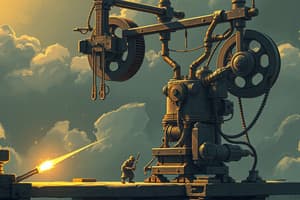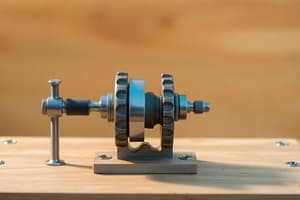Podcast
Questions and Answers
What is the purpose of an idler gear in a gear train?
What is the purpose of an idler gear in a gear train?
- Increase speed
- Decrease force
- Increase mechanical advantage
- Reverse direction (correct)
A gear ratio greater than 1 indicates:
A gear ratio greater than 1 indicates:
- Speed advantage (correct)
- Equal speed and force
- Force advantage
- No advantage
Reducing gears are most useful in:
Reducing gears are most useful in:
- Bicycles
- Sports cars
- Uphill hauling (correct)
- Watches
What happens to the effort force required as mechanical advantage increases?
What happens to the effort force required as mechanical advantage increases?
Which gear type has no effect on speed or force?
Which gear type has no effect on speed or force?
A machine with high efficiency:
A machine with high efficiency:
Which of the following is a simple machine?
Which of the following is a simple machine?
What type of advantage does a fixed pulley provide?
What type of advantage does a fixed pulley provide?
Which simple machine is primarily used in the construction of a ramp?
Which simple machine is primarily used in the construction of a ramp?
In a class 2 lever, where is the load positioned?
In a class 2 lever, where is the load positioned?
Mechanical advantage (MA) is defined as:
Mechanical advantage (MA) is defined as:
Calculate the mechanical advantage of a machine that uses 10 N of effort force to lift a 50 N load.
Calculate the mechanical advantage of a machine that uses 10 N of effort force to lift a 50 N load.
What feature allows the use of a lever to gain a mechanical advantage?
What feature allows the use of a lever to gain a mechanical advantage?
What is the main benefit of using an inclined plane?
What is the main benefit of using an inclined plane?
What is the correct formula for calculating efficiency?
What is the correct formula for calculating efficiency?
What is the efficiency of a ramp with a work input of 200 J and a work output of 150 J?
What is the efficiency of a ramp with a work input of 200 J and a work output of 150 J?
Which option is the primary cause of inefficiency in mechanical systems?
Which option is the primary cause of inefficiency in mechanical systems?
What effect does adding lubricants to moving parts have on efficiency?
What effect does adding lubricants to moving parts have on efficiency?
Increasing the area of the output piston in a hydraulic lift has what effect?
Increasing the area of the output piston in a hydraulic lift has what effect?
Which statement correctly reflects Pascal’s Law?
Which statement correctly reflects Pascal’s Law?
What type of fluid is utilized in a pneumatic system?
What type of fluid is utilized in a pneumatic system?
Kinetic energy refers to energy that is:
Kinetic energy refers to energy that is:
What is the unit of pressure?
What is the unit of pressure?
What is work defined as?
What is work defined as?
What is the formula for work?
What is the formula for work?
How much work is done when a 50 N force moves a box 3 meters?
How much work is done when a 50 N force moves a box 3 meters?
Which of the following is an example of potential energy?
Which of the following is an example of potential energy?
What happens to the potential energy of a ball as it falls?
What happens to the potential energy of a ball as it falls?
Calculate the work done to lift a 10 N object 5 m in height.
Calculate the work done to lift a 10 N object 5 m in height.
Which form of energy is produced by friction?
Which form of energy is produced by friction?
Which energy transformation occurs in a hydroelectric dam?
Which energy transformation occurs in a hydroelectric dam?
What type of energy source powers a hydraulic press?
What type of energy source powers a hydraulic press?
What is the Mechanical Advantage (TMA) of a lever with an effort arm of 4m and a load arm of 1m?
What is the Mechanical Advantage (TMA) of a lever with an effort arm of 4m and a load arm of 1m?
Which of the following objects converts electrical energy to light energy?
Which of the following objects converts electrical energy to light energy?
What formula represents the work done when force is applied over a distance?
What formula represents the work done when force is applied over a distance?
How is energy transformed in a battery?
How is energy transformed in a battery?
Which energy type decreases as it is converted to other forms, according to energy transformations?
Which energy type decreases as it is converted to other forms, according to energy transformations?
What is the significance of friction in mechanical advantage?
What is the significance of friction in mechanical advantage?
Flashcards
What is a lever?
What is a lever?
A simple machine that consists of a rigid bar that pivots around a fixed point called a fulcrum, used to multiply force or change the direction of force.
What is a pulley?
What is a pulley?
A simple machine that consists of a wheel with a groove around its circumference, used to change the direction of force and make it easier to lift objects.
What is an inclined plane?
What is an inclined plane?
A simple machine that consists of a sloping surface, used to move objects over a distance with less effort.
What is a screw?
What is a screw?
Signup and view all the flashcards
What is a gear train?
What is a gear train?
Signup and view all the flashcards
What is mechanical advantage?
What is mechanical advantage?
Signup and view all the flashcards
What is a force advantage in a machine?
What is a force advantage in a machine?
Signup and view all the flashcards
How is mechanical advantage calculated?
How is mechanical advantage calculated?
Signup and view all the flashcards
Efficiency
Efficiency
Signup and view all the flashcards
Efficiency (simple)
Efficiency (simple)
Signup and view all the flashcards
Why is mechanical efficiency less than 100%?
Why is mechanical efficiency less than 100%?
Signup and view all the flashcards
How do lubricants affect efficiency?
How do lubricants affect efficiency?
Signup and view all the flashcards
What is Pascal's Law?
What is Pascal's Law?
Signup and view all the flashcards
What is a hydraulic system?
What is a hydraulic system?
Signup and view all the flashcards
What is a pneumatic system?
What is a pneumatic system?
Signup and view all the flashcards
What is the effect of increasing the output piston area in a hydraulic lift?
What is the effect of increasing the output piston area in a hydraulic lift?
Signup and view all the flashcards
What is the purpose of an idler gear in a gear train?
What is the purpose of an idler gear in a gear train?
Signup and view all the flashcards
What does a gear ratio greater than 1 mean?
What does a gear ratio greater than 1 mean?
Signup and view all the flashcards
When are reducing gears most useful?
When are reducing gears most useful?
Signup and view all the flashcards
What is the effect of an idler gear on speed and force?
What is the effect of an idler gear on speed and force?
Signup and view all the flashcards
What is the effect of increasing mechanical advantage on the effort force required?
What is the effect of increasing mechanical advantage on the effort force required?
Signup and view all the flashcards
What is efficiency in machines?
What is efficiency in machines?
Signup and view all the flashcards
How is the gear ratio calculated?
How is the gear ratio calculated?
Signup and view all the flashcards
What is the characteristic of a machine with high efficiency?
What is the characteristic of a machine with high efficiency?
Signup and view all the flashcards
What is work?
What is work?
Signup and view all the flashcards
What is the formula for work?
What is the formula for work?
Signup and view all the flashcards
What is the unit of measurement for work?
What is the unit of measurement for work?
Signup and view all the flashcards
What is energy?
What is energy?
Signup and view all the flashcards
What is potential energy?
What is potential energy?
Signup and view all the flashcards
What is kinetic energy?
What is kinetic energy?
Signup and view all the flashcards
What is the unit of measurement for energy?
What is the unit of measurement for energy?
Signup and view all the flashcards
What is energy transformation?
What is energy transformation?
Signup and view all the flashcards
Energy Transformation
Energy Transformation
Signup and view all the flashcards
Potential Energy
Potential Energy
Signup and view all the flashcards
Kinetic Energy
Kinetic Energy
Signup and view all the flashcards
Mechanical Advantage (MA)
Mechanical Advantage (MA)
Signup and view all the flashcards
Pressure Energy
Pressure Energy
Signup and view all the flashcards
Work (W)
Work (W)
Signup and view all the flashcards
Lever with Force Advantage
Lever with Force Advantage
Signup and view all the flashcards
Study Notes
Simple Machines
- Simple Machines: A bicycle, screw, and inclined plane are examples
- Mechanical Advantage (MA): Effort force divided by load force
- Lever Class 2: Load is positioned between the effort and the fulcrum
- Effort Arm: Longer than load arm in a lever means speed advantage, shorter means force advantage
- Ramp: A type of inclined plane
- Pulley System: The theoretical mechanical advantage is directly related to the number of ropes supporting the load
Gears
- Idler Gear: Reverses the direction of rotation
- Gear Ratio: Greater than 1 indicates speed advantage
- Reducing Gears: Useful for uphill hauling
- Multiplying Gears: Increase speed
Efficiency
- Efficiency: Work output divided by work input (expressed as a percentage)
- Hydraulic System: Pressure applied to one point is transmitted equally throughout the system increasing the output force
- Lubricants: Reduce friction, increasing efficiency
Work and Energy
- Work: Force applied over a distance
- Formula for Work: Work = Force × Distance
- Kinetic Energy: Energy in motion
- Potential Energy: Stored energy (e.g., a compressed spring)
- Conservation of Energy: Energy cannot be created or destroyed, only transformed
- Energy Transformations: Changing one form of energy to another (e.g., chemical to light, or potential to kinetic)
Studying That Suits You
Use AI to generate personalized quizzes and flashcards to suit your learning preferences.




